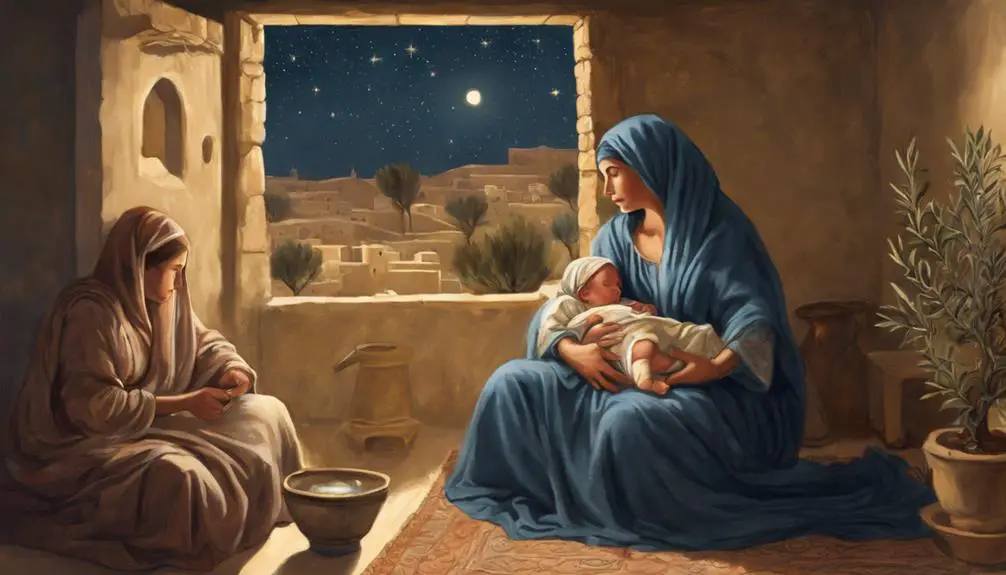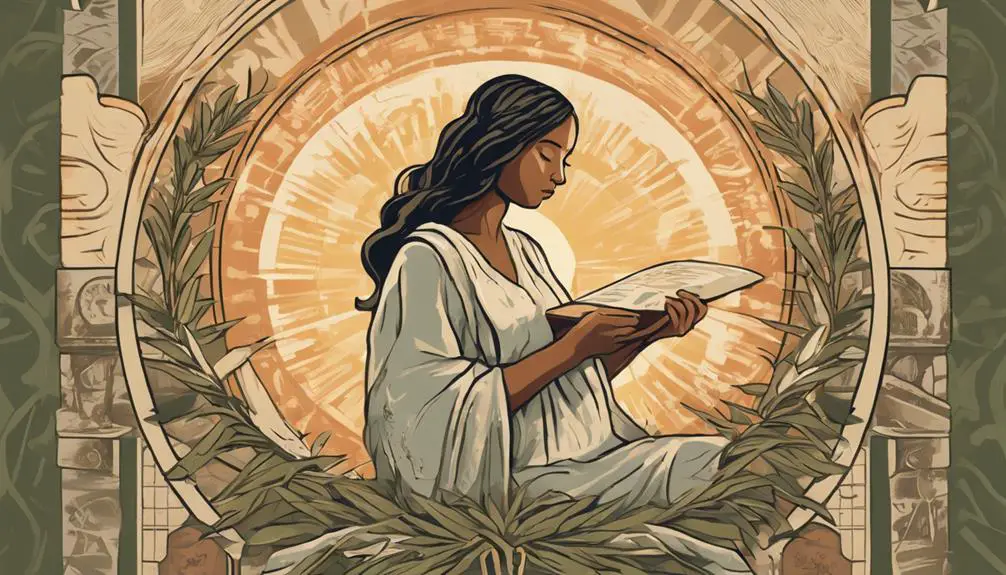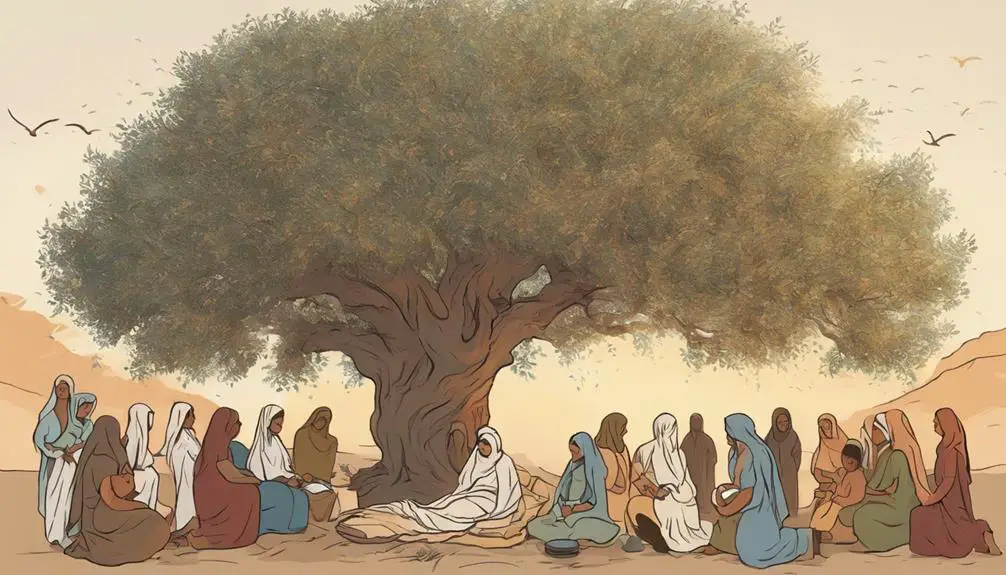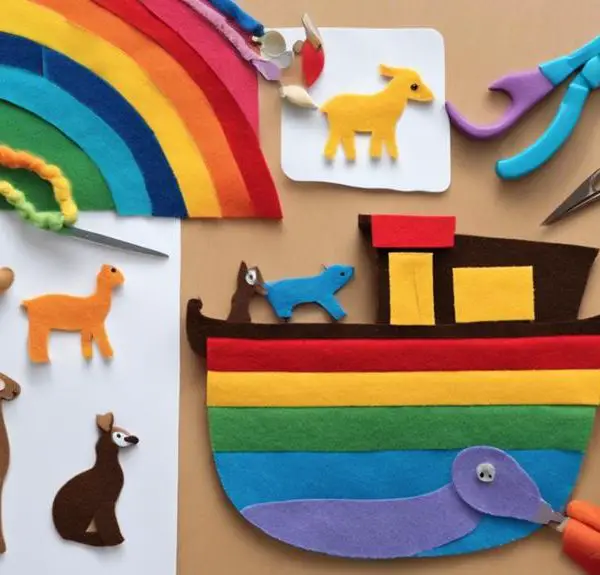Navigate the profound symbolism of birthing pains in biblical narratives, uncovering layers of hope and transformation in these ancient texts.

Birthing Pains in the Bible
You've likely heard theories about the symbolism of birthing pains in biblical texts, but have you ever wondered how deeply these narratives intertwine with ancient traditions and prophetic messages?
The Bible doesn't shy away from the raw and profound aspects of childbirth, embedding these experiences within its verses to convey messages of hope, transformation, and sometimes, divine intervention.
As we explore these passages, you'll find yourself questioning the conventional interpretations and uncovering layers of meaning that could shift your understanding of these ancient texts. Let's embark on this journey together, where the familiar stories might reveal unexpected insights.
Key Takeaways
- Birthing pains in the Bible symbolize the complex interplay of suffering and redemption in human existence.
- Prophetic texts use birth pains metaphorically to herald a new epoch of salvation following tumultuous times.
- The narrative elevates the role of women and childbirth, imbuing them with spiritual and communal significance.
- Miraculous conceptions and maternal blessings within divine narratives underscore the power of God and the theme of covenant.
The Genesis of Birth Pains

In the biblical narrative, the concept of birth pains originates with the story of Eve in the Book of Genesis, marking a fundamental moment that intertwines human existence with the notion of suffering and redemption. This depiction isn't merely a recount of painful origins but serves as a profound foundation for cultural interpretations that span across millennia. You'll find that the narrative doesn't solely aim to explain the physicality of pain associated with childbirth but delves deeper into the symbolic layers of human condition, sin, and the eventual promise of salvation.
This story, while ancient, has been analyzed and reinterpreted through various cultural lenses, underscoring the multifaceted nature of birth pains. It's intriguing to observe how different societies have woven this narrative into their understanding of life, suffering, and the cyclical nature of existence. The cursed pain of Eve is thus not just a tale of origin but a rich, interpretive canvas that invites continuous exploration and understanding. This account, foundational yet open to interpretation, illustrates how painful origins are inherently linked to the broader human experience, offering insights that go beyond the literal to touch upon the universally existential.
Symbolism in Prophetic Texts

Birth pains, as depicted in prophetic texts, serve as a poignant symbol for the tumultuous era preceding the advent of a new, redemptive epoch. You'll find that these narratives, steeped in the cultural contexts of their times, often use the imagery of childbirth to articulate the transition from periods of strife and suffering to the dawn of salvation and restoration. This metaphor resonates deeply within the human experience, capturing the essence of anticipation and transformation inherent in both individual and collective journeys toward renewal.
In exploring these eschatological interpretations, consider the following aspects to deepen your understanding:
- The universality of birth pains across various cultures highlights their symbolic potency in prophetic literature, underscoring shared human experiences of anticipation, pain, and hope.
- Cultural contexts shape the interpretation and significance of these symbols, offering a rich tapestry of meanings that transcend time and geography.
- Eschatological interpretations provide a framework for understanding the transformative potential of suffering, portraying it as a necessary precursor to the emergence of a new order.
Women and Childbirth Traditions

Exploring the role of women and their childbirth traditions offers a compelling lens to understand the deeper symbolism present in prophetic texts, shedding light on the nuanced ways these narratives reflect and shape societal values and beliefs. The invocation of midwifery practices and postnatal customs within these stories isn't merely a backdrop but a critical framework that reveals the profound respect and recognition of women's roles in ancient societies.
Midwifery Practices |
Postnatal Customs |
|---|---|
Guided by wisdom |
Purification rituals |
Hands as healers |
Celebration of life |
Intimate support |
Restorative rest |
Spiritual guidance |
Community support |
Ancestral knowledge |
Renewal ceremonies |
This table not only evokes the emotional depth behind these practices but also emphasizes the integral role of women in the continuum of life and faith. Midwifery practices, deeply rooted in trust and ancestral knowledge, highlight the reverence for life's beginnings. Meanwhile, postnatal customs, from purification rituals to renewal ceremonies, underscore the communal and spiritual journey after childbirth. Through this lens, you grasp the intertwined nature of physical birth and spiritual rebirth, revealing a complex tapestry of faith, tradition, and womanhood that resonates deeply within the biblical narrative.
Metaphors of Transformation

The metaphorical landscape of the Bible often transforms childbirth into a powerful symbol of spiritual renewal and societal change. You find that through the narratives of birth, the text weaves a rich tapestry of metaphors for transformation, signaling not only personal but also communal metamorphoses. These stories don't just recount the physical act of childbirth but elevate it to illustrate pivotal cultural shifts and moments of spiritual rebirth.
To deepen your understanding, consider these aspects:
- Cultural Shifts: Biblical narratives often use childbirth as a metaphor to signify times of transition, reflecting how societies evolve and adapt through periods of turmoil and change.
- Spiritual Rebirth: Just as childbirth heralds a new beginning, many biblical stories parallel this physical act with the concept of spiritual awakening or rebirth, suggesting a metamorphosis from an old to a new state of being.
- Community Transformation: The act of birthing, while deeply personal, is also depicted as a communal event, symbolizing the collective passage through periods of hardship toward renewal or enlightenment.
In dissecting these metaphors, you engage with a layered analysis of how the Bible encapsulates profound truths about human experience and divine intervention through the lens of childbirth.
Divine Narratives of Birth

Delving into the biblical narratives, one finds that divine stories of birth not only recount miraculous events but also embody profound theological implications, illustrating the intersection of the human and the divine. These narratives often highlight miraculous conceptions and maternal blessings, underscoring the belief that divine intervention can manifest in the most personal aspects of human life.
Story |
Miracle |
Implication |
|---|---|---|
Isaac's Birth |
Sarah's old age conception |
Faith and promise |
Samuel's Birth |
Hannah's prayer answered |
Devotion and dedication |
John the Baptist |
Elizabeth's barrenness reversed |
Preparation for the Messiah |
Jesus' Birth |
Virgin birth |
Incarnation and salvation |
In analyzing these stories, you'll notice a pattern: each involves a break from natural expectation, a divine intervention that transforms impossibility into reality. These miraculous conceptions serve not only as signs of God's power but also as markers of significant theological shifts or moments of divine action in human history.
The maternal blessings associated with these births often go beyond the immediate joy of motherhood, encompassing broader themes of deliverance, covenant, and the unfolding of God's plan. Through these narratives, the Bible communicates that God's purposes are often realized through extraordinary means, inviting believers to see the divine hand at work in the world around them.
Frequently Asked Questions
How Do Modern Childbirth Practices and Technologies Relate to or Diverge From the Birthing Narratives Mentioned in the Bible?
When you compare modern childbirth practices to ancient narratives, you'll notice significant divergences due to technological advances and shifting cultural norms.
Today's methods often prioritize safety and pain management, contrasting starkly with historical practices. While the essence of childbirth remains, the approach has evolved, integrating medical advancements that alter the experience.
This evolution reflects not just technological progress but also changes in societal attitudes towards childbirth and women's health.
Are There Specific Prayers or Rituals Mentioned in the Bible That Women or Their Families Performed to Ease Childbirth Pains?
You won't find explicit prayers or rituals in the Bible aimed specifically at easing childbirth pains. However, ancient practices around childbirth, including those hinted at in biblical times, often involved midwives and might've included forms of ritual purification.
While the scripture doesn't detail these practices directly, it's clear that communities valued and sought divine intervention and protection during the vulnerable time of childbirth, aligning with broader ancient midwifery traditions.
How Have Interpretations of Biblical Birth Pains Influenced Contemporary Religious Views on Pain Management During Childbirth, Such as the Use of Epidurals or Other Medical Interventions?
When examining how contemporary religious views on pain management during childbirth have evolved, it's crucial to delve into pain theology and epidural ethics.
You'll find that interpretations vary widely. Some communities might see medical interventions like epidurals as contrary to spiritual teachings about enduring pain, while others interpret these options as aligning with compassionate care.
It's a complex interplay between faith, ethics, and the advancement of medical technology.
What Role Do Men Play in the Birthing Narratives of the Bible, and How Does This Compare to Their Role in Modern Childbirth?
In biblical narratives, men often play peripheral roles, rooted in patriarchal narratives that reflect their times.
Today, there's been a significant cultural shift. Men are more actively involved in childbirth, from support in the delivery room to participating in decisions about pain management.
This transition highlights evolving perceptions of gender roles and shared parenting responsibilities, diverging from historical precedents where men's roles were largely confined to the periphery of childbirth experiences.
Can the Concept of 'Birth Pains' Found in the Bible Offer Any Insights Into the Emotional and Psychological Challenges of Parenting Beyond the Actual Process of Giving Birth?
You're exploring how parenting metaphors, like 'birth pains,' shed light on the emotional resilience needed in parenting. This concept doesn't just relate to physical birth but extends to the continual challenges and joys of raising children.
It suggests that just as labor requires strength and endurance, so does the parenting journey. This interpretation invites a deeper understanding of the emotional and psychological resilience that parenting demands, beyond the act of giving birth.
Conclusion
In analyzing the biblical narratives, it's clear that birth pains aren't merely physiological events but carry profound symbolic weight. They signify transformation, not just for the woman but within the socio-religious fabric.
These narratives, rich in metaphor, intertwine the physical act of birthing with divine intervention and prophecy. By delving into these texts, you've unraveled layers of meaning that highlight the complexities of birth, reflecting broader themes of suffering, renewal, and divine purpose in the biblical worldview.



Sign up